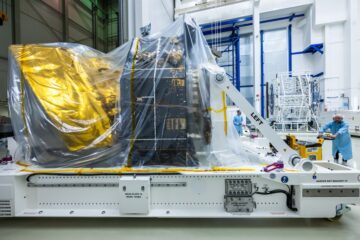Continuing our weekly instalments outlining astronomy’s impact on your everyday life, we have an article by Jan Mathijs van der Hulst. Thijs is an astronomer, Professor of Radio Astronomy at the University of Groningen, and member of the IAU’s Division B steering committee. Below he outlines how time keeping owes its origin to understanding the celestial motions apparent in our skies.
The rhythm of day and night and the apparent motion of the Sun, Moon and stars led to the concept of time and the calendar. Navigation relies on precision time keeping, as well as Einstein’s theory of relativity, for its accuracy.
The concept of a day was tied to the motion of the Sun and the concept of a month was tied to the phase and position of the Moon. The concept of hour can be traced back to the Egyptians who divided the day into 10 parts, with an extra part before and after to allow for sunrise and sunset. Time was very important for navigation on the seas, and it was not until mechanical clocks were invented (in the 16th and 17th century by Galileo and Huygens) that sailors were able to determine their position at sea with precision to avoid shipwrecks.

Throughout history many calendars have used, mostly tied to particular cultures or regions, each using the concept of days, but with their own definitions of a year or calendar cycle. The calendar most widely used today is the Gregorian calendar, based on the old Roman calendar and introduced by Pope Gregory XIII in 1582. To keep in sync with the motion of the Earth around the Sun he introduced the leap year. Once every four years an extra day is added to the month of February to correct for the fact that the year really is 365.2425 days long, rather than 365 days.

Keeping accurate time is no longer done using mechanical clocks, but with high precision atomic clocks where the frequency of an atomic transition is used as a standard to keep track of time. The first atomic clock was built at the US National Bureau of Standards and was based on the atomic properties of an ammonia absorption line at 23870.1 MHz. Later, caesium and rubidium clocks were built that had much greater precision. The world’s time is now based on International Atomic Time, kept by a few hundred atomic clocks at various institutions around the world. Global time keeping started at the Paris Observatory, which housed the International Time Bureau (BIH), responsible for combining the time of all atomic clocks around the world. Its task is now carried out by the International Bureau of Weights and Measures and the International Earth Rotation and Reference Systems Service.
The latter organisation is responsible for keeping clocks in sync with the motion of the Earth around the Sun and the Earth’s own rotation. These are measured very precisely using strong and distant radio astronomy sources – radio galaxies and quasars – as a reference frame. This is the so-called ephemeris time. The measurements are carried out regularly using radio telescopes around the world. The main services are at the US Naval Observatory and Paris Observatory. As a result of their measurements the time is regularly updated with one or more ‘leap seconds’, similar to the ‘leap year’ introduced in the Gregorian Calendar, but now on an immensely finer time scale. The last leap second was added on 31 December 2016.

The ability to keep accurate time is essential for the Global Positioning System (GPS) satellites. These have accurate atomic clocks on board tuned to ephemeris time. The precise knowledge of the time and their positions makes it possible to use their signals for accurate position determination on the surface of the Earth. To reach the high precision required for navigation the software evaluating the GPS signals needs consider the effects of relativity to account for the relative motion of the clocks on the satellites with respect to the device that receives the GPS signals and calculates its position. They also need to take into account the slightly different gravitational field the satellite clocks experience. So, without knowledge of both Einstein’s Special Theory of Relativity (for the relative motion) and General Theory of Relativity (for the gravitational fields), GPS would not have been able to reach the high precision it achieves, of a few metres.



0 Comments